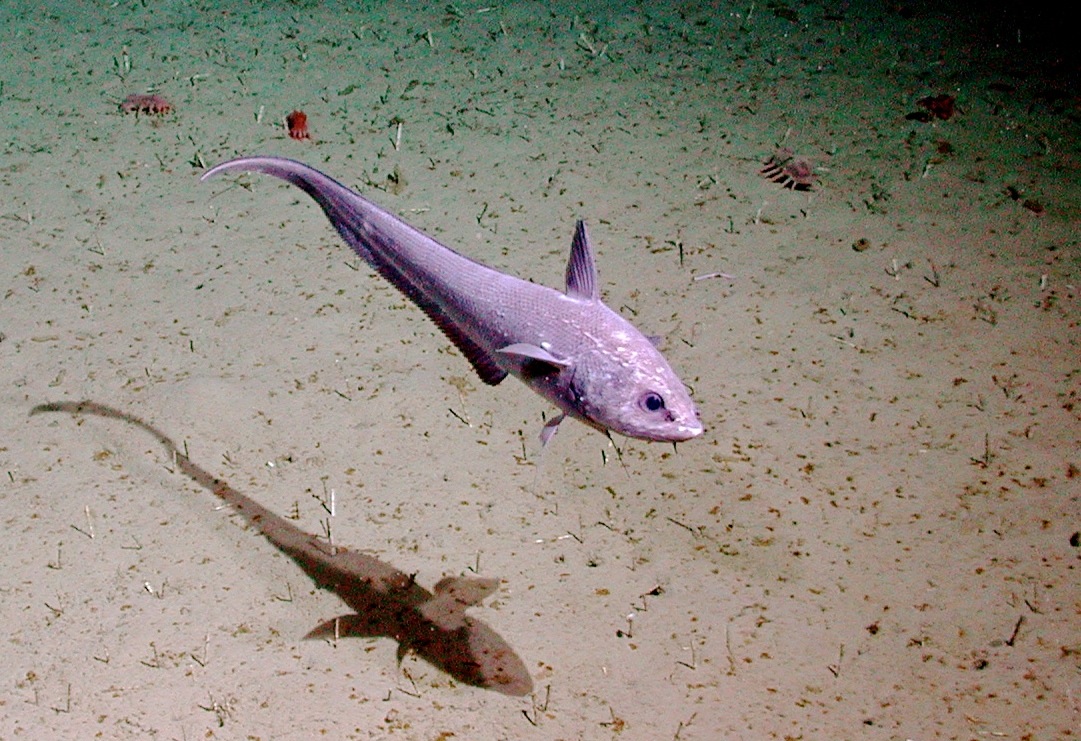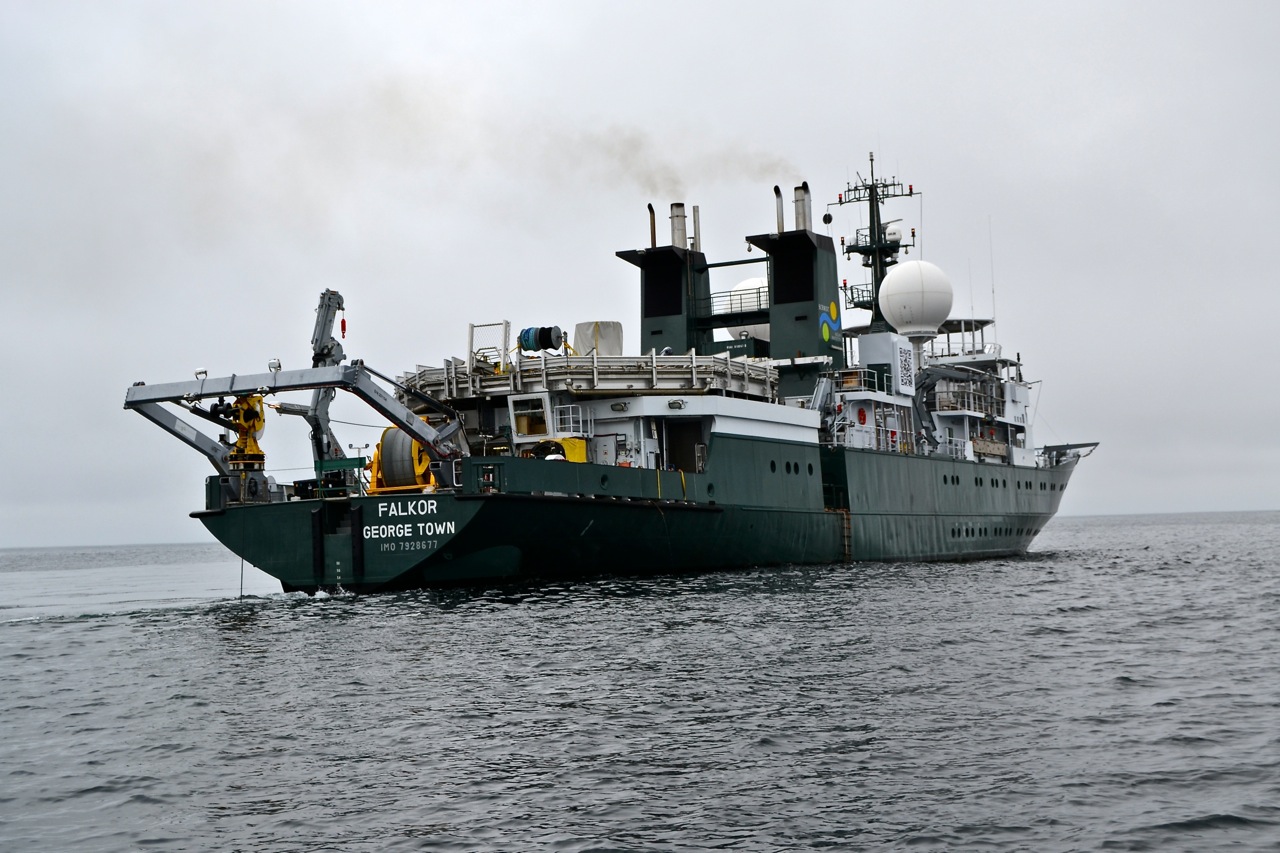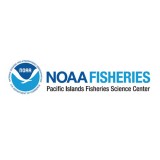The very deepest reaches of the sea are one of the planet’s last true frontiers. That’s mostly because a lack of support for needed technological advancements and vehicles has severely limited access to depths beyond 7,000 meters.
But the situation is finally beginning to change, and SOI is helping push the process forward. In November, the institute collaborated with a group of biologists and geologists working aboard R/V Falkor to conduct a new study of one of the deepest places in the world.
The team deployed SOI’s new full-ocean-depth landers—frames equipped with cameras, sensors and sample collection devices that return to the surface automatically after a set time on the seafloor—as well as three other landers, in the Mariana Trench’s Sirena Deep, near Guam. The work, at depths down to almost 11,000 meters, will help answer enduring questions about the biology of such alien zones, including who lives there and how they survive the massive pressure. The research should also improve understanding of the processes that control earthquake and tsunami formation, among others geological goals. And of course, with so little exploration having been done in the trench, there were surprises.
The original plan for this expedition called for using Woods Hole Oceanographic’s Nereus hybrid remotely operated vehicle. But sadly, Nereus was lost earlier this year.
Why It’s Still a Frontier
Places deeper than 6,000 meters—known as the hadal zone—have remained a frontier mainly because so few vehicles have ever been built to penetrate such depths. A handful of robotic and manned vehicles can go to 6,500 or 7,000 meters down. But that leaves almost half the ocean’s depth range inaccessible, and a collective seafloor area almost as large as Australia.
Only four vehicles have ever existed that could safely work at full ocean depth and none are currently in operation. Of course scientists have found other ways to get limited glimpses of the deepest regions, as they did on this expedition with landers. Work with this type of equipment has been critical—indeed SOI returned to the Mariana Trench in December of 2014 on a second lander project.
Ultimately researchers hope to systematically explore large swaths of the world’s deepest trenches to get a more complete view of what is found there. Such work will once again be possible by 2016 as Schmidt Ocean Institute is working with Woods Hole on a new full-ocean-depth robotic vehicle.
The Big Questions
Jeff Drazen from University of Hawaii at Manoa (UH), a deep-sea fish expert, was the expedition’s chief scientist, while Patricia Fryer, a geologist also at UH, was co-chief scientist. One key goal was to learn more about what animals are found in the trench, and what factors might control these animals’ locations and concentrations.
Working with samples caught in traps they also studied the biochemical adaptations that allow animals to survive the crushing pressures in deep trenches, in particular, whether these animals have special compounds to protect proteins in their cells from folding improperly under the crushing pressure. One of the compounds researchers have already found that seems to help some trench dwellers withstand hadal pressure was discovered elsewhere and is being pursued as a potential treatment for Alzheimer’s, which involves problems with protein folding in the brain. Other compounds discovered in the trenches might be new to science and could offer similar potential medical or other benefits.
The team also equipped one lander with modified coring devices that inserted a tube into the sediment and meaured the amount of oxygen used by the worms and other small organisms found there. This effort tied to past work suggesting that more food ends up in trenches than previously thought, and that this food—in a range of forms including falling dead phytoplankton, animals, droppings and other materials—could support more life than expected. Food concentrations might also determine where more animals congregate. The oxygen consumption rates offered a measure of the abundance and activity of sediment dwellers that can in turn be compared to location and sediment data to look for patterns in the ways that animals are distributed.
Another lander was equipped with a rock grabber that allowed the team to collect samples that can help answer key geological questions. Trenches form at the places where tectonic plates run into each other, with one falling, or being subducted, underneath the other. That process, along with associated microbial activity, plays important roles in the release and consumption of carbon and minerals. Such cycling is, for instance, a critical factor in the ocean’s ability to absorb carbon dioxide from the atmosphere.
Much of our understanding of these processes, despite their importance, remains theoretical because they occur so deep that opportunities for study have been extremely rare. Rock and sediment sample analyses could either confirm some of the current understanding of these processes, or reveal new questions scientists need to ask.
Trench subduction zones are also the sites of earthquakes that at times spawn devastating tsunamis. Observations and sample analyses could also help scientists better understand factors tied to these events.
The Bigger Picture
The Falkor expedition was planned as part of the international Hadal Ecosystems Studies program, led by Woods Hole Oceanographic’s Tim Shank, who was part of the Mariana Trench team.
The Mariana Trench expedition also included researchers from Whitman College, the University of Aberdeen’s Oceanlab, New Zealand’s National Instiute of Water and Atmospheric Research, the UK’s Natural Environment Research Council, and the National Oceanography Centre, also in the UK. The cruise ran from November 9 to December 9, 2014. Cclick on the buttons in the upper left corner to follow the Cruise Log and the Expedition Map.
by Mark Schrope
Data & Publications
The resulting shipboard dataset is being stored at the Rolling Deck to Repository and is now available.
ADCP data is curated and archived by University of Hawaii.
The resulting bathymetric dataset from the multibeam mapping of the Mariana Trench using R/V Falkor’s Kongsberg EM302 and EM710 is being stored at the Interdisciplinary Earth Data Alliance’s Marine Geoscience Data System (IEDA:MGDS). This data is also being stored at the NOAA National Center for Environmental Information (NCEI). You can view all Falkor data sets by using the Filter Surveys button on the left sidebar.
Biological and Geological Samples: Spreadsheet of biological and geological sample collections from the FK141109 Mariana Trench cruise.
Amphipod, Fish, Other Megafauna, Rock, and Sediment Collections are archived at the Biological and Chemical Oceanography Data Management Office.
Treatment dataset for new species Eurythenes plasticus is available here.
- Linley, T.D., Gerringer, M.E., Yancey, P.H., Drazen, J.C., Weinstock, C.L., Jamieson, A.J., (2016). Fishes of the hadal zone including new species, in situ observations and depth records of hadal snailfishes. Deep Sea Research,114, 99-110. DOI:10.1016/j.dsr.2016.05.003. [This publication is available as OPEN ACCESS].
- Gerringer, M., Linley, T., Jamieson, A., Goetze, E., and J. Drazen. (2017). Pseudoliparis swirei sp. nov.: A Newly-discovered Hadal Snailfish (Scorpainiformes: Liparidae) from the Mariana Trench, Zootaxa 4358:1, doi: 10.11646/zootaxa.4358.1.7. [This article has been published as OPEN ACCESS].
- Gerringer, M., Drazen,J., and P. Yancey. (2017). Metabolic Enzyme Activities of Abyssal and Hadal Fishes: Pressure Effects and a Re-evaluation of Depth-related Changes. Deep-Sea Research Part I: Oceanographic Research Papers, 125:135-146, doi:10.1016/j.dsr.2017.05.010. [This article has been published as OPEN ACCESS].
- Gerringer, M., Popp, B., Linley, T., Jamieson, A., and J. Drazen. (2017) Feeding Ecology of Hadal Fishes; Comparative Analyses of Stomach Contents and Compound Specific Stable Isotopes of Individual Amino Acids. Deep-Sea Research Part I: Oceanographic Research Papers 121:110-120, doi:10.1016.j.dsr.2017.01.003. [This article has been published as OPEN ACCESS].
- Jamieson, A., Malkocs, T., Piertney, S., Fujii, T., and Z. Zhang. (2017). Bioaccumulation of Persistent Organic Pollutants in the Deepest Ocean Fauna. Nature Ecology & Evolution, 1:0051, doi:10.1038/s41559-016-0051. [This article has been published as OPEN ACCESS].
- Linley, T., Stewart, A., McMillan, P., Clark, M., Gerringer, M., Drazen, J., Fujii, T., and A. Jamieson. (2017). Bait Attending Fishes of the Abyssal Zone and Hadal Boundary: Community Structure, Functional Groups and Species Distribution in the Kermadec, New Hebrides and Mariana Trenches. Deep-Sea Research Part I: Oceanographic Research 121:38-53, doi:10.1016/j.dsr.2016.12.009.
Anna B. Downing, Gemma T. Wallace, Paul H. Yancey, (2018). Organic osmolytes of amphipods from littoral to hadal zones: Increases with depth in trimethylamine N-oxide, scyllo-inositol and other potential pressure counteractants. Deep Sea Research Part I: Oceanographic Research Papers. DOI/10.1016/j.dsr.2018.05.008
- Downing, A., Wallace, G., and Yancey, P. (2018). Organic osmolytes of amphipods from littoral to hadal zones: Increases with depth in trimethylamine N-oxide, scyllo-inositol and other potential pressure counteractants. Deep Sea Research Part I: Oceanographic Research Papers 138 (1-10), doi: 10.1016/j.dsr.2018.05.008.
- Gerringer, M., Andrews, A., Huss, G., Nagashima, K., Popp, B., Clark, M., Linley, T., Jamieson, A., and J. Drazen. (2018). Life history of abyssal and hadal fishes from otolith growth zones and oxygen isotopic compositions. Deep Sea Research I, 132: 37-50, doi: 10.1016/j.dsr.2017.12.002. [This article has been published as OPEN ACCESS].
Zhang, W., Tian, R.-M., Sun, J., Bougouffa, S., Ding, W., Cai, L, Lan, Y., Tong, H., Li, Y., Jamieson, A., Bajic, V.-B., Drazen, J., Bartlett, D., and P.-Y. Qian. (2018). Genome reduction in Psychromonas species within the gut of an amphipod from the Ocean’s deepest point. mSystems 3(3), doi: 10.1128/mSystems.00009-18. [This article has been published as OPEN ACCESS].
- Gerringer, M. (2019). On the success of the hadal snailfishes. Integrative Organismal Biology, obz004, doi: 10.1039/iob/obz004. [This article has been published as OPEN ACCESS].
- Gerringer, M., Yancey, P., Tikhonova, O., Vavilov, N., Zgoda, V., and D. Davydov. (2020). Pressure Tolerance of Deep-sea Enzymes can be Evolved through Increasing Volume Changes in Protein Transitions: A Study with Lactate Dehydrogenases from Abyssal and Hadal Fishes. FEBS Journal, doi: 10.1111/febs.15317.
- Tokuda, A., Drazen, J., Gerringer, J., Popp, B., Grammatopoulou, E., and Mayor, D. (2020). Tropic interactions of megafauna in the Mariana and Kermadec trenches inferred from stable isotope analysis. Deep Sea Research: Part 1 Oceanographic Research Papers, vol. 164, doi: 10.1016/j.dsr.2020.103360. [This article has been published OPEN ACCESS].
- Peoples, L., Grammatopoulou, E., Pombrol, M., Xu, X., Oladayo, O., Blanton, J., et. al. (2019). Microbial Community Diversity within Sediments from Two Geographically Separated Hadal Trenches. Front. Microbiol. Vol. 10, doi: 10.3389/fmicb.2019.00347.
- Peoples, L., Donaldson, S., Osuntokun, O., Xia, Q., Nelson, A., Blanton, J. et. al. (2018). Vertically Distinct Microbial Communities in the Mariana and Kermadec Trenches. Plos One, 13(4), doi: 10.1371/journal.pone.0195102. [This article is published as OPEN ACCESS].
- Blum, J., Drazen, J., Johnson, M., Popp, B., Motta, L., and Jamieson, A. (2020). Mercury isotopes identify near-surface marine mercury in deep-sea trench biota. Proceedings of the National Academy of Sciences Nov 2020, 117(47) 29292-29298, doi: 10.1073/pnas.2012773117. [This article has been published as OPEN ACCESS]
- Stewart, H., and Jamieson, A. (2018). Habitat heterogeneity of hadal trenches: Considerations and implications for future studies. Progress in Oceanography, 161, 47-65, doi: 10.1016/j.pocean.2018.01.007. [This article has been published as OPEN ACCESS].
- Ritchie, H., Jamieson, A., and Piertney, S. (2017). Genome size variation in deep-sea amphipods. Royal Society Open Science, 4(9), doi: 10.1098/rsos.170862. [This article has been published as OPEN ACCESS].
- Weston, J., Carrillo-Barragan, P., Linley, T., Reid, W., and Jamieson, A. (2020). New species of Eurythenes from hadal depths of the Mariana Trench, Pacific Ocean (Crustacea: Amphipoda). ZooTaxa, 4748(1), doi: 10.11646/zootaxa.4748.1.9. [This article has been published as OPEN ACCESS].
- Gerringer, M., Dias, A., von Hagel, A., Orr, J., Summers, A., and Farina, S. (2021). Habitat influences skeletal morphology and density in the snailfishes (family Liparidae). Frontiers in Zoology, 18(16), doi: 10.1186/s12983-021-00399-9. [This article has been published as OPEN ACCESS with support from SOI].
- Gerringer, M., Linley, T., and Nielsen, J. (2021). Revision of the depth record of bony fishes with notes on hadal snailfishes (Liparidae, Scorpaeniformes) and cusk eels (Ophidiidae, Ophidiiformes). Marine Biology, 168, 167, doi: 10.1007/s00227-021-03950-8. [This article is published OPEN ACCESS].
- Jamieson, A., Linley, T., Eigler, S., and Macdonald, T. (2021). A Global Assessment of Fishes at Lowe Abyssal and Upper Hadal Depths (5000 to 8000 m). Deep-sea Research Part 1, 178, 103642, doi: 10.1016/j.dsr.2021.103642.
- Swan, J., Jamieson, A., Linley, T., and Yancey, P. (2021). Worldwide Distribution and Depth Limits of Decapod Crustaceans (Penaeoidea, Oplophoroidea) across the Abyssal-hadal Transition Zone of Eleven Subduction Trenches and Five Additional Deep-sea Features. Journal of Crustacean Biology. 41(1), doi: 10.1093/jcbiol/ruaa102.
- Jamieson, A., Stewart, H., Weston, J., and Bongiovanni, C. (2021). Hydrozoans, Scyphozoans, Larvaceans and Ctenophores Observed in situ at Hadal Depths. Journal of Plankton Research, 43(1): 20-32. doi:10.1093/plankt/fbaa062.
- Blanton, J., Peoples, L., Gerringer, M., Iacuaniello, C., Gallo, N., Linley, T., et al. (2022). Microbiomes of Hadal Fishes across Trench Habitats Contain Similar Taxa and Known Piezophiles. mSphere, 7(2), doi: 10.1128/msphere.00032-22. [This article is published as OPEN ACCESS].
- Schwarzhans, W., and Gerringer, M. (2023). Otoliths of the deepest-living fishes. Deep Sea Research Part I: Oceanographic Research Papers, 198, doi: 10.1016/j.dsr.2023.104079.
In the News
NSU Researcher Part of Team Addressing Potential Risks to Marine Life from Deep-Sea Mining
Newswise • July 9, 2020
NSU Researcher Part of Team Addressing Potential Risks to Marine Life from Deep-Sea Mining
Health News Digest • July 9, 2020
Scientists Warn of Wide Impacts on Midwaters Around Deep-Sea Mining Sites
The State of the Planet – Columbia University • July 8, 2020
Exploring the Deepest Part of the Ocean
All Things Marine Radio Show • November 18th, 2014
New Record for Deepest Fish
BBC • December 18th, 2014
How Scientists Found Deepest-Ever Fish
ABC News • December 19th, 2014
Palo Alto Ocean Institute Discovers New Fish
ABC News San Francisco • December 19th, 2014
Sea Ghost! Scientists Spot Deepest Living Fish
NBC News • December 19th, 2014
New Record: Ethereal Deep-Sea Fish 5 miles Underwater
LA Times • December 19th, 2014
Ghostly New Fish Discovered at Record-Breaking Depths
The Washington Post • December 19th, 2014
Deepest Fish Found 5 Miles Down
USA Today • December 19th, 2014
Bizzare, Ghost-Like Animal Sets New Record for Deepest Living Fish
IFLS • December 19th, 2014
Scientists Just Discovered the Deepest Dwelling Fish Species
MTV News • December 19th, 2014
Weird Sea Ghost Breaks Record for Deepest Living Fish
New Scientist • December 19th, 2014
Bizarre-Looking Creature Break’s Record
Fox News • December 19th, 2014
Bizarre Looking Creature Break’s World Record
NBC News – North Carolina • December 19th, 2014
Unexpected Life Found In The Ocean’s Deepest Trench
National Public Radio (NPR) • December 25th, 2014
World’s Deepest Fish
Canada Journal • December 19th, 2014
Video Shows Snailfish Swimming Deeper Than Any Other Creature
The Independent • December 19th, 2014
Found: The World’s Newest Deepest-Dwelling Fish
Popular Science • December 19th, 2014
New Fish Species Discovered
PBS News Hour • December 19th, 2014
New Species Found in the Deepest Trench on Earth
Science Daily • December 20th, 2014
Strange New Fish at Record Breaking 5 Miles Deep
Houston Chron • December 20th, 2014
World’s Deepest Fish Found in Pacific Ocean
The Telegraph • December 20th, 2014
Scientists Discover World’s Deepest-Dwelling Fish Species
Dehli Daily News • December 21st, 2014
Worlds Deepest Fish Found in Mariana Trench
Mariana Trench Variety • December 22nd, 2014
Deepest Fish Features Angel Wings, Tentacles and Amazing Ability to Perform Under Pressure
Scientific American • January 8th, 2015
Deepest Place on Earth Contains ‘Extraordinary’ Pollution Levels
National Geographic • February 2nd, 2017
There’s a deeper fish in the sea
UW News • November 28th, 2017
Meet the deepest fish in the sea: The Mariana snailfish, identified with UW’s help
GeekWire • November 28th, 2017
Meet the deepest fish in the sea: The Mariana snailfish, identified with UW’s help
World News • November 28th, 2017
New Fish Species Lives 5 Miles Underwater—a Record
National Geographic • November 29th, 2017
New fish species discovered from depths of Mariana Trench
Graffio Tech • November 29th, 2017
Mariana Snailfish: Deepest-ever Fish Discovered at 26000 Feet under the Sea
Tupactu • November 29th, 2017
Researchers Discover The Ocean’s Deepest Fish Yet
CBS Miami • November 29th, 2017
World’s Deepest-Living Fish Found Five Miles Beneath the Sea Surface
Gizmodo • November 29th, 2017
The World’s Deepest-Living Fish Is Surprisingly Cute
Atlas Obscura • November 29th, 2017
There’s a deeper fish in the sea
University of Hawai’i News • November 29th, 2017
Meet the deepest fish in the sea: The Mariana snailfish, identified with UW’s help
Rockstar Page • November 29th, 2017
The deepest-dwelling fish in the sea is small, pink and delicate
The Conversation • February 1st, 2018












